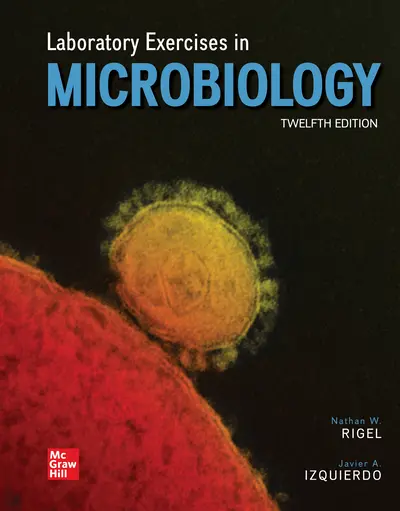My Account Details

ISBN10: 1264775660 | ISBN13: 9781264775668

* The estimated amount of time this product will be on the market is based on a number of factors, including faculty input to instructional design and the prior revision cycle and updates to academic research-which typically results in a revision cycle ranging from every two to four years for this product. Pricing subject to change at any time.
Instructor Information
Quick Actions (Only for Validated Instructor Accounts):
The Rigel lab is a majors level manual that accompanies our Willey – Prescott’s Microbiology textbook. This laboratory manual provides a balanced introduction to laboratory techniques and principles that are important in each area of microbiology. Experiments follow the spirit of the ASM guidelines for laboratory content. Each experiment comes with a complete set of pedagogical aids—materials per group of students, learning objectives, pronunciation guide— so students understand the “how” and “why” of the labs in which they participate. This lab manual also comes with Connect and the Virtual Labs.
Microscopic Techniques
1. Bright-Field Light Microscopy and Microscopic Measurement of Organisms
2. The Hanging Drop Slide and Bacterial Motility
3. Dark-Field Light Microscopy
4. Phase-Contrast Microscopy
PART TWO
Bacterial Cell Biology
5. Aseptic Technique
6. Negative Staining
7. Simple Staining
8. Gram Stain
9. Acid-Fast Staining Procedure
10. Endospore Staining
11. Capsule Staining
12. Flagella Staining
PART THREE
Basic Culture Techniques
13. Preparation of Microbiology Media and Equipment
14. The Spread-Plate Technique
15. The Streak-Plate Technique
16. The Pour-Plate Technique
17. Cultivation of Anaerobic Bacteria
18. Determination of Bacterial Numbers
PART FOUR
Microbial Biochemistry
19. Carbohydrates I: Fermentation and β-Galactosidase Activity
20. Carbohydrates II: Triple Sugar Iron Agar Test
21. Carbohydrates III: Starch Hydrolysis
22. Lipid Hydrolysis
23. Proteins I: The IMViC Tests
24. Proteins II: Gelatin and Casein Hydrolysis
25. Proteins III: Catalase Activity
26. Proteins IV: Oxidase Test
27. Proteins V: Urease Activity
28. Proteins VI: Lysine and Ornithine Decarboxylase Tests
29. Proteins VII: Phenylalanine Deamination
30. Proteins VIII: Dissimilatory Nitrate Reduction
PART FIVE
Environmental Factors Affecting Growth of Microorganisms
31. Temperature
32. pH
33. Osmotic Pressure
34. The Effects of Chemical Agents on Bacteria I: Disinfectants and Other Antimicrobial Products
35. The Effects of Chemical Agents on Bacteria II: Antibiotics
36. Bacterial Growth Curve
PART SIX
Environmental and Food Microbiolog
37. Monitoring Water for Coliforms
38. Enumeration of Soil Microorganisms
39. Winogradsky Columns
40. Bioluminescence
41. Plate Counts and Quality Assessment of Milk
PART SEVEN
Medical Microbiology
42. Staphylococci
43. Pneumococcus
44. Streptococci
45. Neisseriae
46. Normal Human Flora
PART EIGHT
Eukaryotic Microbiology
47. Fungi I: Yeasts (Ascomycota)
48. Fungi II: Zygomycota (Rhizopus), Ascomycota (Penicillium), and Basidiomycota (Agaricus)
Need support? We're here to help - Get real-world support and resources every step of the way.